Support Us
Since 1979 more than 140,000 animals have been treated by Wildlife Rescue.
Thanks to the support of individuals like you, Wildlife Rescue can provide a lifeline for animals in distress.
 Now that spring is well on its way, many of us are looking to get started on the season's gardening so that we can enjoy a beautiful outdoor space all summer. You can get your backyard ready for yourself and... Read More
Now that spring is well on its way, many of us are looking to get started on the season's gardening so that we can enjoy a beautiful outdoor space all summer. You can get your backyard ready for yourself and... Read More
Today is #WorldWetlandsDay, crucial to our environment, wetlands provide a habitat for a variety of animals such as fish, birds, invertebrates and are an essential part of the earth’s ecosystem. Despite how essential they are to the environment, wetlands are facing challenges daily across the globe.
Read MoreAs we roll into the fall and crisp leaves fall to the ground, birds take to the skies. This time of year, adults and their young begin their journey south in search of warmer climates.
Migration can be like an obstacle course for these feathered travelers. They can be thrown off their route by city lights of buildings and towers and crash into windows. These challenges cause exhaustion and starvation among stranded wildlife.
Read MoreThe wildfires, north and south of Vancouver have, at times, made it hard to breathe and have given us a sense of “unease”. Even though we live in urban settings and the wildfires are hundreds of kilometers away, we still feel the impact of the fires. Wildlfe Rescue provides care to hundreds of birds at this time of year, some displaced by wildfires and many, many injured in window and car impacts.
Read MoreEvery year, approximately five billion pounds of pesticides are used to control pest populations – harming local wildlife on the ground, sea, and sky. Chemical pest control solutions are a common part of our lives – whether it is a golf course, restaurant, or our own home. These different chemicals have a fatal effect on our wildlife – even threatening some wildlife populations. Each chemical may have a different impact on wildlife some fatal, others may bioaccumulate and others may pose no harm.
Read MoreThe Sora is a small waterbird of the family Rallidae, sometimes referred to as the sora rail or sora crake. This small chicken-like bird is chubby with uniquely long toes that help it to tackle floating vegetation when searching for food. Soras are grayish-brown with white-edged feathers, a dark throat patch with vertical white lines, a black mask from the bill to the eye and a white patch under the tail. The bill is bright yellow which might make you think of Hallowe’en candy corns.
Read MoreIdeally, all hummingbird feeders should be taken down in September of each year before migration begins. Leaving feeders up will not discourage migration, as hummingbirds that migrate are instinctually driven to do so, however; it can alter their behaviors. In some cases, these feeders are left up unknowingly and without proper care, which can ultimately lead to the fungal infections, starvation and death of the hummingbirds which have become dependent on them for survival.
Read MoreOver the last 10 years, the Eurasian Collared-Dove who often is mistaken for a pigeon has become a frequent visitor and resident on the west coast of Canada. Their history originates from Asia to the Bahamas in the 70’s and slowly into the United States where they were found in Florida and moving further into other parts of North America. These exotic birds are still scarce, but the numbers are increasing as bird watchers are noticing their presence throughout the lower mainland, Fraser Valley, Okanagan, and along the coast.
Read MoreRecently, one juvenile Pelagic Cormorant was found on Granville street bridge where a Good Samaritan rescued him just before he was hit by a car. Unfortunately, incidents like these are a common occurrence – many birds nest on the bridge trestles (under the bridge on the structure/framework), making them more at-risk to car accidents, human disturbances and predatorial challenges.
Read More